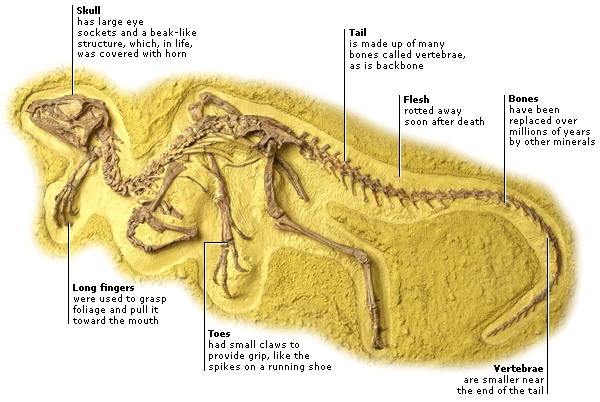DK Science: Palaeontology
The study of ancient life, known from FOSSILS, is called palaeontology and scientists who work in this field are known as palaeontologists. By looking closely at fossil skeletons and comparing them with those of living animals, palaeontologists try to work out what extinct creatures looked like and how they might have lived. They also use other clues from so-called “trace fossils” – preserved footprints and other remains of prehistoric animal activity.

Complete dinosaur skeletons are rare. It is more usual to find just a few teeth or bones. Palaeontologists identify isolated fossils by comparing and matching them with bones from better-preserved specimens. To flesh out dinosaur skeletons, scientists calculate the size and position of muscles from the marks left where they attached to the bones.

In recent decades, large numbers of dinosaur eggs have been discovered. Some are preserved in clutches of a dozen or more, suggesting that dinosaurs made nests. There is even one example of a dinosaur preserved with a clutch of eggs – evidence that there may have been some kind of parental care.
Palaeontologists study more than just bones. Prehistoric creatures such as dinosaurs left other evidence of their lives behind. By looking at fossil footprints, palaeontologists can work out how dinosaurs moved and even how quickly they ran. As well as footprints, fossil dinosaur droppings have been found. These tell palaeontologists what these creatures ate.
Fossils are the only evidence of prehistoric life. They occur in sedimentary rocks, which form from compacted sediments, such as silt and sand. Rapid burial in sediment prevents the animal from breaking up or being eaten by scavengers. Over time what remains may be bone, or replaced by minerals, or dissolved out, leaving a mould of the animal’s shape. Fossils are exposed by water or weather wearing away the rock they are in.

Some animals have hardly changed since they appeared, millions of years ago. They are referred to as living fossils, a term first used by Charles Darwin. This horseshoe crab is virtually identical to fossil horseshoe crabs from Jurassic times, 200 million years ago. Its body has stayed the same because it is perfectly adapted to its habitat and lifestyle, which have never changed.
Trilobites are extinct animals that had a tough outer skeleton, jointed legs, and compound eyes – features seen in today’s insects and crustaceans. They became extinct about 248 million years ago, but were very common sea creatures in the 300 million years before that time.
Amber is fossilized tree resin. Sometimes it contains the remains of insects and other small animals that became trapped in it as it oozed from the tree. Evidence from these almost perfect fossils provides rare information about soft tissues and delicate structures. Attempts have been made to extract DNA from these fossils, but so far none have been successful.
